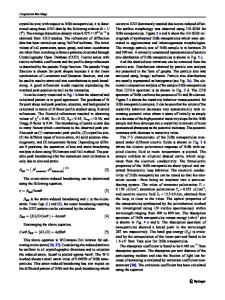Synthesis of LNF Nanoparticles for Fuel Cell Applications
- PDF / 2,106,523 Bytes
- 6 Pages / 612 x 792 pts (letter) Page_size
- 94 Downloads / 387 Views
1230-MM06-08
Synthesis of LNF Nanoparticles for Fuel Cell Applications M.Reza Bateni1, M.Nasirpour1, O.Kesler1* 1 Dept. of Mechanical & Industrial Eng., University of Toronto, Toronto, Ontario, Canada *Corresponding Author ABSTRACT: The aim of the present work is to understand the effect of different parameters such as the molar ratio of metallic ions to fuel in sol-gel solution, pH of the solution, and calcining temperature on the efficiency of the combustion synthesis technique in preparing submicron lanthanum nickel ferrite using metal nitrate-citrate/glycine mixtures. Scanning electron microscopy (SEM) coupled with energy-dispersive X-ray spectroscopy (EDS) was used to evaluate the powder morphology and elemental composition. The crystal structure of the calcined powders was evaluated by X-ray diffraction (XRD) and the thermal characteristics of the LNF precursors were examined by thermo-gravimetric analysis (TGA) in air, to identify suitable processing conditions. It was found that by increasing the molar ratio of fuel to metallic ions in the precursor solution, calcining could take place at lower temperatures. However, by increasing the molar ratio of fuel to metallic ions, the yield of the combustion process was decreased. Furthermore, the pH of the precursor solution did not have any influence on the process efficiency over the range examined. INTRODUCTION Solid oxide fuel cells (SOFCs) have attracted a great deal of attention as clean energy conversion devices because of their high conversion efficiency of fuel energy to electrical energy, low greenhouse gas emissions, very low air pollution emissions, and high system compactness [1]. A single cell repeat unit is made of a cathode, anode, electrolyte, and interconnect. The ideal electrode should be able to conduct electrons and ions, should have a similar coefficient of thermal expansion to that of the electrolyte, be resistant to chromium poisoning on the cathode side, and be resistant to carbon deposition and sulfur poisoning on the anode side. At present, the most conventional cathode is made of lanthanum strontium manganite (LSM). However, its low ionic conductivity has led to the use and investigation of other materials [2]. Among various perovskites, LaNi1-xFexO3-δ has been shown to have suitable characteristics as a cathode material for intermediate temperature solid oxide fuel cells (IT-SOFCs). In the LaNi1–xFexO3-δ series, LaNi0.6Fe0.4O3-δ (LNF) has the highest conductivity, a small thermal expansion coefficient mismatch with zirconia electrolytes, high electrochemical activity for oxygen reduction, and good stability against chromium species originating from metallic interconnects [3,4,5]. Although there are various methods to synthesize ceramic powders, combustion synthesis techniques are among the most attractive methods, for they can provide homogeneous nano-size particles via an easy and fast self-ignited combustion process using metal nitrates and fuel [6, 7]. In this study, citric acid and glycine were used as fuels to synthesize LaNi0.6Fe0
Data Loading...











